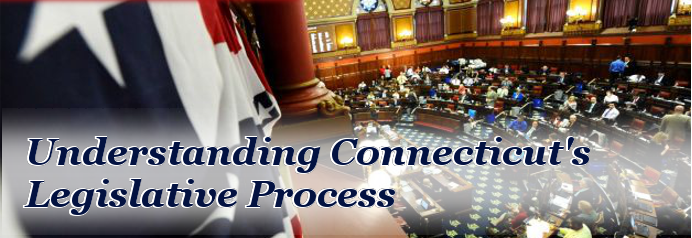
By Pam Lucashu
Here in Connecticut, the State Legislature–also referred to as the Connecticut General Assembly (CGA)–is comprised of two branches–the House of Representatives and the Senate. The House is composed of 151 members, while the Senate is composed of only 36 members. Both Representatives and Senators are elected to two-year terms.
Short and Long Sessions
The Connecticut legislature has divided its legislative sessions into odd and even years in order to focus on different subjects. Even year sessions are shorter, running from February to early May. In odd years the session is longer, running from January to early June.
How Does an Idea Become Law?
In order for an idea to become law, it must be introduced by legislators or committees in the form of a “bill”. If a citizen wants to introduce legislation, he must ask his state senator or representative to introduce it.
There are several different kinds of bills that can be introduced–Proposed Bills,Committee Bills, Raised Bills, and Governor’s Bills. Individual legislators may introduce “Proposed Bills”. The deadline for filing proposed bills is early in the session–approximately two weeks after the beginning of session. Committees may also propose bills. These are screened by the committee leadership before filing. Proposed bills are drafted in general terms–often only a sentence describing the goal or subject matter of the legislation. If the bill is selected by Committee leadership to go forward, it will be drafted in full statutory language and become a Committee bill. Failure to become a Committee bill, however, does not mean the bill has died. It might be seen later as a raised bill, as part of a raised bill, or as an amendment to a related bill. In fact, the cliché is that no bill is truly dead in CT until the legislature has adjourned that year’s session.
Raised bills are also drafted in formal statutory language and have been developed by Committee leadership. They may or may not have begun with an idea from a proposed bill. Raised bills have later deadlines than Proposed or Committee bills. Finally, Governor’s Bills are usually budget-related and are submitted by the Governor to the General Assembly.
Bills proposed by a House member are numbered to indicate such: HB 501, for instance. Bills introduced by a Senator are designated as SB ___, and Raised Bills are marked RB. The full numbering system and explanation of the bill terms can also be found at About Bills on the CGA website.
Where Do Public Hearings Come Into the Picture?
In order for a committee to report a bill favorably (known as “Joint Favorable Report” or JF for short) and send a bill for a full vote of the CT General Assembly, it must first hold a public hearing. At the hearing, the public and state agencies, representatives and legislators may testify on the bill. Testifying at a public hearing requires signing up (and usually waiting) to testify, as well as providing copies of the written testimony. Tips on testifying–from the number of copies of your testimony to provide, to dress and decorum–are available on the CGA website at Your Voice Matters at the Connecticut General Assembly.
“Making It Out of Committee”
Because the Committees consist of members of both the House and the Senate, once a committee “JF’s” a bill, it will not have to wait for further committee review, but can be sent to the chamber of the bill’s author for a vote. Once a bill is JF’d to the floor, it will be processed by the Legislative Commission Office (LCO). The LCO will turn it into a file copy, with a new file copy number, final text of the bill as passed by committee, fiscal notes prepared by the Office of Fiscal Analysis and an analysis by the Office of Legislative Research.
Public Act vs. Law
Once a bill passes both houses of the legislature it becomes a public act. It does not become a law until either the Governor signs it or a certain amount of time passes without his signature. The Governor can also veto the bill, in which case 2/3 of the full legislature must vote to pass the bill.

Pam Lacashu is a veteran homeschool mom of 3 grown children.
She is an attorney who is also involved in local politics and currently
volunteers as Legislative Liaison for TEACH CT.